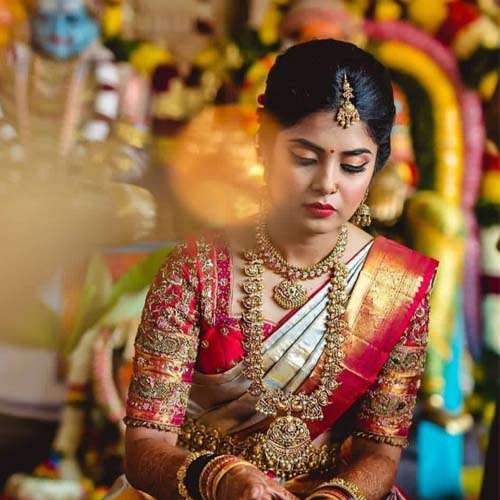
Bridal Kanjivaram Sarees, also known as Bridal Kanchipuram Silk Sarees, represent the pinnacle of Indian bridal attire. Renowned for their opulent silk fabric, intricate designs, and vibrant colors, these sarees are not just garments but works of art that embody centuries of tradition and craftsmanship. This article explores the rich heritage, detailed craftsmanship, and enduring allure of Bridal Kanjivaram Sarees.
The Heritage of Kanjivaram Sarees
The origins of Kanjivaram sarees for wedding can be traced back to the town of Kanchipuram in Tamil Nadu, often referred to as the “Silk City” of India. This region has a rich history of silk weaving that dates back over 400 years. The weavers of Kanchipuram, primarily from the Devanga and Saligar weaver communities, have perfected their craft over generations, creating sarees that are celebrated for their durability, texture, and intricate patterns.
The Making of a Bridal Kanjivaram Saree
The creation of a Bridal Kanjivaram Saree is a labor-intensive process that involves a high level of skill and precision. The journey begins with the selection of the finest mulberry silk, known for its strength and luster. The silk threads are meticulously hand-spun and dyed using natural dyes to achieve the desired vibrant colors.
The weaving process is what truly sets Kanjivaram sarees apart. Traditionally, the saree is woven on a handloom, a process that can take anywhere from 10 to 20 days depending on the complexity of the design. The weavers use a technique called “korvai” to interlock the borders with the body of the saree, ensuring a seamless blend that enhances the overall aesthetic.
Gold and silver threads, also known as “zari,” are used to create the intricate motifs that adorn Bridal Kanjivaram Sarees. These motifs often draw inspiration from South Indian temples, mythology, and nature, featuring designs such as peacocks, flowers, and chariots. The use of real zari, which is made from silver and gold, adds a rich and luxurious feel to the saree, making it a perfect choice for a bride.
The Significance of Bridal Kanjivaram Sarees
Bridal Kanjivaram Sarees hold immense cultural and emotional significance in Indian weddings. They are more than just a traditional outfit; they symbolize purity, prosperity, and the rich cultural heritage of South India. Wearing a Bridal Kanjivaram Saree on the wedding day is seen as a mark of respect for tradition and family values.
Each Kanjivaram saree is a masterpiece, reflecting the skill and dedication of the weaver. For many brides, these sarees are treasured heirlooms passed down through generations, each with its own story and legacy. The weight, sheen, and intricate designs of these sarees make the bride look resplendent, embodying grace and elegance.
Modern Adaptations and Contemporary Trends
While the traditional charm of Bridal Kanjivaram Sarees remains unmatched, modern brides are increasingly looking for designs that blend tradition with contemporary aesthetics. Today, designers are experimenting with new color palettes, innovative motifs, and lighter weaves to cater to the evolving tastes of brides.
Some popular contemporary trends include the use of pastel shades, fusion designs that incorporate elements from other Indian weaving traditions, and personalized motifs that tell a unique story. Despite these innovations, the essence of the Kanjivaram saree remains intact, with the emphasis on quality silk, real zari, and expert craftsmanship.
The Role of Weavers and Handloom Cooperatives
The artisans behind Bridal Kanjivaram Sarees are the true custodians of this ancient craft. Their expertise and dedication are crucial in maintaining the high standards associated with these sarees. Many weavers work with handloom cooperatives that support and sustain their craft, ensuring fair wages and access to quality raw materials.
Handloom cooperatives play a vital role in preserving the heritage of Kanjivaram weaving. They provide a platform for weavers to showcase their work, connect with buyers, and receive training in new techniques. By supporting these cooperatives, consumers can contribute to the sustainability of this exquisite art form.
Conclusion
Bridal Kanjivaram Sarees are a testament to the rich cultural heritage and unparalleled craftsmanship of Indian weavers. Each saree is a woven dream, encapsulating the beauty, tradition, and artistry that have been honed over centuries. The vibrant colors, intricate designs, and luxurious feel of Bridal Kanchipuram Silk Saree make them a cherished part of a bride’s trousseau, symbolizing not only her entry into a new phase of life but also the continuation of a timeless tradition.
As we celebrate the craftsmanship of Bridal Kanjivaram Sarees, it is essential to recognize and support the artisans who bring these masterpieces to life. By appreciating the skill and dedication involved in creating each saree, we can ensure that this beautiful heritage continues to thrive, weaving dreams for generations to come.



